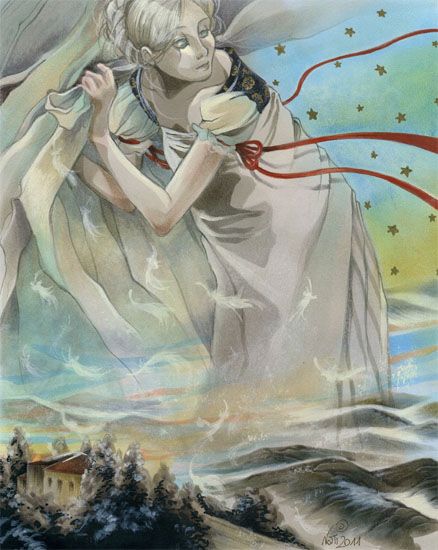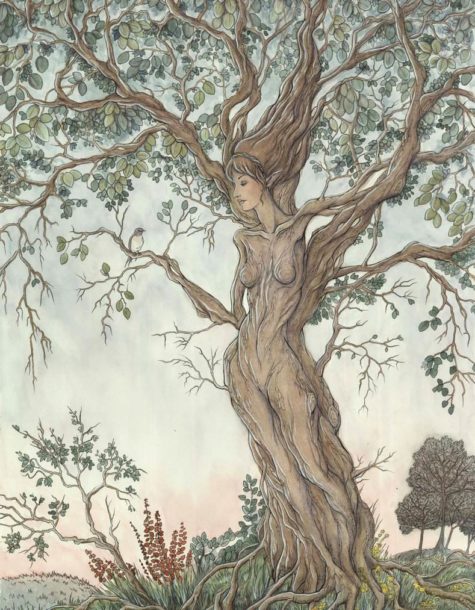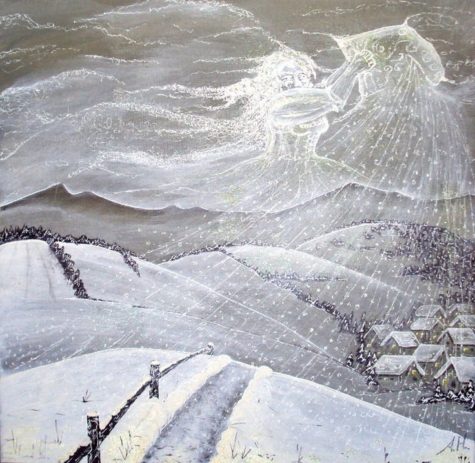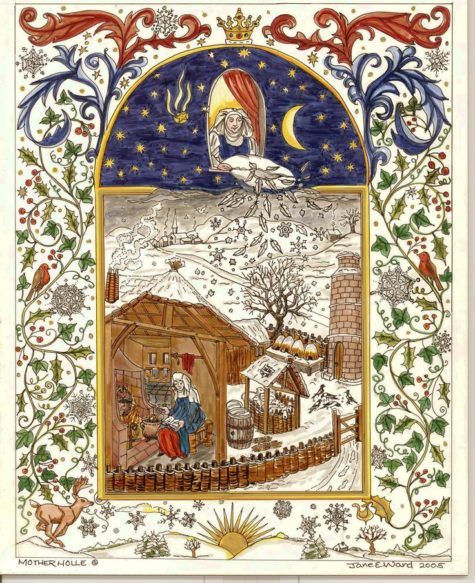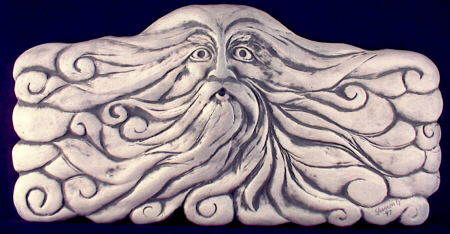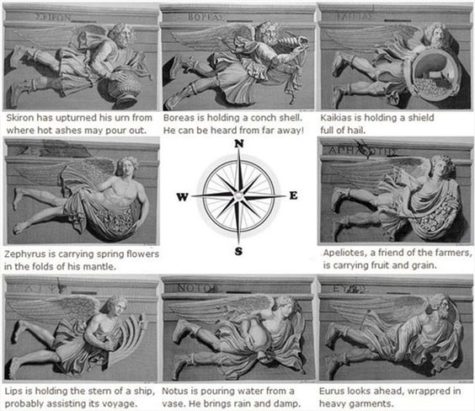Weather
- Also known as: Mother Holle, Frau Holle, Hulde
- Origin: Teutonic
- Realms: The sky, underground, mountains, wells
- Constellation: The Milky Way is the street she travels
- Elements: Earth, air, water
- Sacred animals: Wolves, Rabbits
- Color: White, blue
- Spirit Ally: Odin, with whom she sometimes leads the Wild Hunt
- Plants: Holly, elder, juniper, mugwort, flax, Sorcerer’s Violet (Vinca major – sometimes called Frau Holle)
- Sacred Days: The Winter Solstice is Hulda’s feast day. The twelve days between Dec 25 and Jan 6 are sacred to Hulda.
- Offerings: She loves music and dancing.
Manifestations:
A radiantly beautiful blond woman or a fierce old crone. In her guise as Queen of Witches, she has disheveled hair and a wild look.
She may also manifest as a woman when seen from the front but a tree from behind. She may be accompanied by an entourage of torch bearing rabbits who light her way.
About Hulda:
Hulda, a great and ancient goddess of birth and death, presides over a transit station for human souls, a crossroads between life and death. Hulda receives the souls of the newly dead into her realm and releases newborns to live new lives on Earth. Hulda bathes at midday in a fountain from which babies emerge, a well of life.
She was no unknown spirit but a prominent Northern European goddess. Holland is her namesake. Her name may be related to “holy.” Hulda lives in mountain caves and among elder trees, portals to her realm. Her realm may also be accessed via wells. She is sometimes witnessed walking alongside rivers or mountain paths, alone or accompanied by an entourage of rabbits and Fairies. She may be Queen of the Elves.
She plays a prominent part in German folk-lore and superstition. In stormy nights she can be often heard flying through the air, accompanied by weird spirits and witches. On such occasions it is dangerous for ill-doers to be abroad, as they will surely meet with severe punishment; while to the good she frequently appears as a benefactor. Her particular season is winter.
Hulda is a weather spirit. When she shakes her feather bed, it snows on Earth. Rain falls from her laundry rinse water. Fog hovering over a mountain may be smoke from Hulda’s fire. She guards and nurtures all the growing things of the forest. She was a culture-goddess, too, credited with introducing flax to Europe and teaching the art of making linen.
Banished after official conversion to Christianity, people were forbidden to venerate or contact Hulda. Those maintaining that practice were branded witches. Hulda was reclassified as a demon witch-goddess who attacked and harmed children.
She retains dominion over Pagan babies. People were urged to baptize their babies lest they end up in Hulda’s realm. Mother Holle, once so benevolent was transformed into a monster. People warned their children that if they weren’t obedient, Hulda would “get” them.
Vestiges of rituals invoking Hulda’s blessings on baby girls were retained by Ashkenazi Jews (the Hollekreisch), whether because Pagan women found discreet safety in that community rather than convert to Christianity or because Jews perceived Hulda’s resemblance to Lilith. Although rituals survive, many would be shocked and horrified to realize that they invoke a Pagan goddess.
Like Lilith, Hulda is not always so benevolent these days. She is a proud and resolutely Pagan spirit with little patience for hypocrites. Hulda can bestow fertility but she can take it away, too. She has power over storms, raising them as well as soothing them. She can be ambivalent toward people as demonstrated by Mother Holle, the Brothers Grimm fairytail in which she stars.
The theme involves young girls who wander into Hulda’s domain, either inadvertently or deliberately in anticipation of a reward. She rewards the girl who respects her and follows her commands with effort and devotion but causes excrement to rain down upon the lazy, disrespectful girl.
Found in:
- Encyclopaedia of Superstitions, Folklore, and the Occult Sciences
- The Encyclopedia of Spirits
- Origin: Greece
- Festival Days: Jan 16 and 17 – Greek festival in which offerings were made to the Wind Gods of the Eight Directions
In ancient Greek religion and myth, the Anemoi (Greek: Ἄνεμοι, “Winds”) were wind gods who were each ascribed a cardinal direction from which their respective winds came, and were each associated with various seasons and weather conditions.
They were sometimes represented as mere gusts of wind, at other times were personified as winged men, and at still other times were depicted as horses kept in the stables of the storm god Aeolus, who provided Odysseus with the Anemoi in the Odyssey. The Spartans were reported to sacrifice a horse to the winds on Mount Taygetus. Astraeus, the astrological deity, and Eos/Aurora, the goddess of the dawn, were the parents of the Anemoi, according to the Greek poet Hesiod. The daughters of the Anemoi are the Aurae (wind nymphs).
According to Hesiod, the beneficial winds, Notus, Boreas, Argestes, and Zephyrus, were the sons of Astraeus and Eos, and the destructive ones, as Typhon, are said to be the sons of Typhoeus. Later, especially philosophical writers, endeavoured to define the winds more accurately, according to their places in the compass.
The Anemoi are divided into two groups:
- Anemoi Major
- Boreas: North Wind
- Eurus: East Wind
- Notus: South Wind
- Zephyr: West Wind
- Anemoi Minor
- Apeliotes: Southeast Wind
- Kaikias: Northeast Wind
- Livos (Lips): Southwest Wind
- Skiron (Skeiron): Northwest Wind
Of the four chief Anemoi, Boreas (Aquilo in Latin) was the north wind and bringer of cold winter air, Zephyrus (Favonius in Latin) was the west wind and bringer of light spring and early summer breezes, and Notos (Auster in Latin) was the south wind and bringer of the storms of late summer and autumn; Eurus, the southeast (or according to some, the east) wind, was not associated with any of the three Greek seasons, and is the only one of these four Anemoi not mentioned in Hesiod’s Theogony or in the Orphic Hymns.
Other Minor Wind Deities:
- Argestes “clearing”, a wind blowing from about the same direction as Skiron (Caurus), and probably another name for it
- Aparctias, sometimes called the north wind instead of Boreas
- Thrascias, the north-north-west wind (sometimes called in Latin Circius)
- Euronotus, the wind blowing from the direction, as its name suggests, between Euros and Notos, that is, a south-southeast wind (Euroauster to the Romans)
- Iapyx, the northwest wind about the same as Caurus. It was this wind, according to Virgil, that carried the fleeing Cleopatra home to Egypt after she was defeated at the battle of Actium.
- Libonotus, the south-southwest wind, known as Austro-Africus to the Romans
- Meses, another name for the north-west wind Skiron
- Olympias, apparently identified with Skiron/Argestes
- Phoenicias, another name for the southeast wind (“the one blowing from Phoenicia”, due to this land lying to the south-east of Greece)
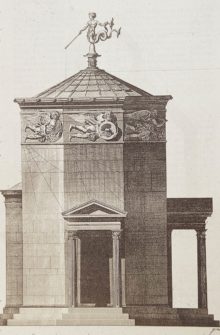 The most remarkable monument representing the winds is the octagonal tower of Andronicus Cyrrhestes at Athens. Each of the eight sides of the monument represents one of the eight principal winds in a flying attitude.
The most remarkable monument representing the winds is the octagonal tower of Andronicus Cyrrhestes at Athens. Each of the eight sides of the monument represents one of the eight principal winds in a flying attitude.
A moveable Triton in the centre of the cupola pointed with his staff to the wind blowing at the time.
All these eight figures have wings at their shoulders, all are clothed, and the peculiarities of the winds are indicated by their bodies and various attributes.
This is how it looks today:
